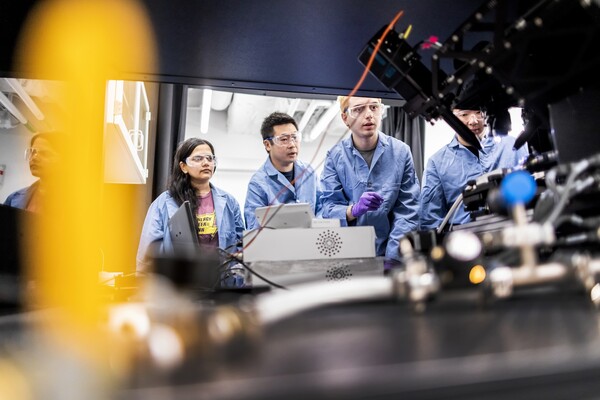
Image: Mininyx Doodle via Getty Images

Most biomedical researchers spend their days in quiet anonymity, patiently enduring months or years of costly exploration before striking gold. For Drew Weissman and Katalin Karikó, this was certainly the case for the majority of their scientific careers. Even after making a series of discoveries that transformed messenger RNA (mRNA) into a viable vaccine platform more than 15 years ago, they flew under the radar.
Then came COVID-19.
Without the mRNA technology foundation laid by Karikó and Weissman, the Pfizer/BioNTech and Moderna vaccines being deployed across the world would not exist. Now, the researchers are receiving global acclaim, not just for their role in providing hundreds of millions of vaccines doses amidst a pandemic, but also for the boundless potential they unleashed to tackle other diseases now and in the future.
When they contemplate the false starts and adversity they weathered to get to this point, they can only marvel at the direction life has taken.
Born and raised behind the Iron Curtain in a small town in Hungary, Karikó, now a BioNTech executive and adjunct professor of neurosurgery at the Perelman School of Medicine, could give a master class in resilience. She immigrated to the U.S. in 1985 in search of professional advancement, having developed a singular focus on unleashing the power of mRNA to fight disease.
In the early 1990s, researchers were quickly developing a more nuanced understanding of how the body uses mRNA to instruct cells on which proteins to make to remain alive and healthy. Karikó reasoned that by altering this mRNA, she could create proteins with vast therapeutic potential, from enzymes that reverse disease to antibodies that fight infection.
She spent the majority of the 1990s applying for government and corporate grants that would give her the chance to translate hypotheses into results. After years of rejected applications, she decided to press on despite limited funding. In 1997, she met Weissman, a gifted immunologist who had recently joined the faculty at Penn fresh out of a fellowship under the supervision of Anthony Fauci at the National Institutes of Health. They struck up their first conversations at Penn by the copy machine where both were printing personal copies of journal articles to keep up with their distinct, but soon to overlap, fields.
While Karikó was laser-focused on therapeutic applications for mRNA, Weissman, who currently serves as the Roberts Family Professor of Vaccine Research at the Perelman School of Medicine, has always directed his energies toward applying mRNA research to vaccine development and gene therapy.
After they first crossed paths, Karikó agreed to create mRNA for Weissman, who needed it to develop vaccines for diseases like HIV. In return, Weissman introduced her to immunology. Each provided expertise the other lacked, and the result was nothing short of revolutionary.
“I always wanted to alter mRNA to make it therapeutic,” Karikó says, “but working shoulder to shoulder with Drew, I ended up laying the groundwork for mRNA vaccines instead.”
In retrospect, the road to success was strewn with roadblocks and detours. By 2000, Karikó and Weissman hit a major obstacle in their joint research effort. Rather than reaching its target cells and instructing them to make proteins, the modified mRNA they created was triggering an inflammatory cytokine production in cultured human immune cells.
We’re only beginning to discover all the ways we can use mRNA. At Penn and beyond, there is so much more to come.
Drew Weissman, the Roberts Family Professor of Vaccine Research at the Perelman School of Medicine
Each strand of mRNA is made up of four different molecular building blocks called nucleosides. In 2005, Weissman and Karikó recognized that in the synthetic version of mRNA, a building block called uridine was triggering the inflammatory response that rendered the mRNA useless. By replacing it with a slightly altered version, they were able to avoid inflammation altogether. In 2015, they added to their discovery by developing a delivery technique that uses lipid nanoparticles to package the mRNA in a way that helps deliver it to its intended target.
Together, these findings opened new windows of possibility for mRNA vaccines. “Our research reignited interest in mRNA vaccines, and the field really took off,” Weissman says.
In the years prior to COVID-19, a coronavirus pandemic couldn’t have been further from the minds of Karikó and Weissman. They were focused on testing mRNA vaccines for pathogens like genital herpes and influenza.
But when the pandemic struck, they knew that their 15-year-old discoveries could provide a roadmap to stem the toll—and fast. “We knew that one of the advantages of an mRNA vaccine was how quickly it could be created,” Weissman says.
In the COVID-19 mRNA vaccines, modified mRNA instructs cells to create proteins that look like the characteristic spike proteins that the virus uses to enter the body’s cells. The body responds to the perceived threat of a foreign protein by creating antibodies to combat it, even though it never actually confronts the virus itself.
Phase 1/2 clinical trials of both mRNA vaccines from Moderna and Pfizer/BioNTech showed signs of early promise, and by Phase 3, the vaccines were shown to offer, respectively, 94% and 95% protection from symptomatic disease caused by the virus. “At this point, we were both incredibly relieved,” Weissman says. “What works in mice rarely works in men.”
To date, a combined 360 million doses of the Pfizer/BioNTech and Moderna vaccines have been administered in the U.S. alone, with an additional 125 countries using the Pfizer/BioNTech vaccine and 70 countries using the Moderna vaccine.
These days, the pair is approaching celebrity status in the biomedical research community, having won the Princess of Asturias Award, the Albany Medical Center Prize in Medicine and Biomedical Research, the $3 million Breakthrough Prize, the Benjamin Franklin Medal in Life Science, and, most notably, the 2021 Lasker Award—America’s top biomedical research prize—for their role in creating the vaccine.
Between ongoing research projects, awards ceremonies, and media appearances, Weissman and Karikó have found very little down time. “My wife and kids joke that I’m happiest when I’m left alone in my lab,” Weissman says. “This sudden change of pace has been a shock to the system.”
Karikó, who didn’t receive a single award in the first 40 years of her career, is also trying to wrap her head around her newfound celebrity. In addition to the many notes of congratulations and encouragement from Penn colleagues and students, she and Weissman frequently receive expressions of gratitude from strangers all over the world. “It’s humbling to receive such an outpouring of support because we were just a few of many people at Penn, as well as BioNTech, who contributed to this achievement,” Karikó says.
Ultimately, what Karikó and Weissman discovered years ago was a platform, not a treatment for a single disease. The genius of the mRNA technology lies in its limitless potential. In a setup often referred to as “plug and play,” researchers only need to plug in the sequence of the protein they want to create or replace to target a specific disease.
Another advantage of mRNA technology is speed. To create live vaccines used to inoculate against diseases like measles, mumps, and rubella, or inactivated vaccines like those used for flu and polio, researchers must transport and replicate actual pathogens during the manufacturing process. By circumventing the need for actual pathogens, mRNA vaccines allow for faster production and flexible delivery.
I always wanted to alter mRNA to make it therapeutic, but working shoulder to shoulder with Drew, I ended up laying the groundwork for mRNA vaccines instead.
Katalin Karikó, a BioNTech executive and adjunct professor of neurosurgery at the Perelman School of Medicine
Weissman is seizing on these advantages to ensure that the world is ready for the next incarnation of coronaviruses. He and his lab are hard at work developing a pan-coronavirus vaccine capable of protecting the population against SARS, MERS, SARS-CoV-2, and any future variants and coronaviruses. At BioNTech, where Karikó serves as senior vice president, she is overseeing parallel but distinct research on a range of diseases in which patients receive mRNA encoding therapeutic proteins.
Like branches of a tree, research projects based on Weissman and Karikó’s foundational research are sprouting quickly at Penn. A growing number of groups, some involving Weissman, are undertaking mRNA research related to cancer, neuro-development disorders, other infectious diseases, genetic conditions, and animal health.
In early 2022, Weissman will partner with Harvey Friedman, a professor of infectious diseases and an HSV researcher, to begin human clinical trials of an mRNA vaccine for herpes, the most common sexually transmitted disease. At the newly created Center of Excellence for Influenza Research and Response, Scott Hensley, a professor of microbiology, is creating mRNA vaccines for a wide range of shapeshifting influenza virus strains.
In addition, mRNA technology has also shifted the goalposts for cancer research, as Karikó and Weissman discovered in collaboration with colleagues like Norbert Pardi, a research assistant professor of infectious diseases, who Karikó had mentored in Hungary before both senior investigators supervised his postdoctoral work at Penn. The researchers discovered that mRNA vaccines can not only create immune response to viruses like COVID-19, but can also boost the response of cytotoxic T cells in fighting cancer cells.
Developing mRNA vaccines for cancer presents a unique challenge, since most antibodies in tumor cells are specific to each individual, but researchers are feeling their way through the darkness step by step. At least eight pharmaceutical companies, many in collaboration with institutions like Penn, are studying cancer vaccines in ongoing clinical trials.
Nearly 25 years ago, a chance meeting at a photocopier lit the fuse for a revolution in mRNA technology. Now, hundreds of researchers around the world are picking up the mantle. “We’re only beginning to discover all the ways we can use mRNA,” Weissman says. “At Penn and beyond, there is so much more to come.”
To learn more about ongoing mRNA research at Penn Medicine, visit https://www.pennmedicine.org/mrna.
Ashley Rabinovitch
Dan Burke , Peggy Peterson

Image: Mininyx Doodle via Getty Images

The sun shades on the Vagelos Institute for Energy Science and Technology.
nocred

Image: Pencho Chukov via Getty Images

nocred